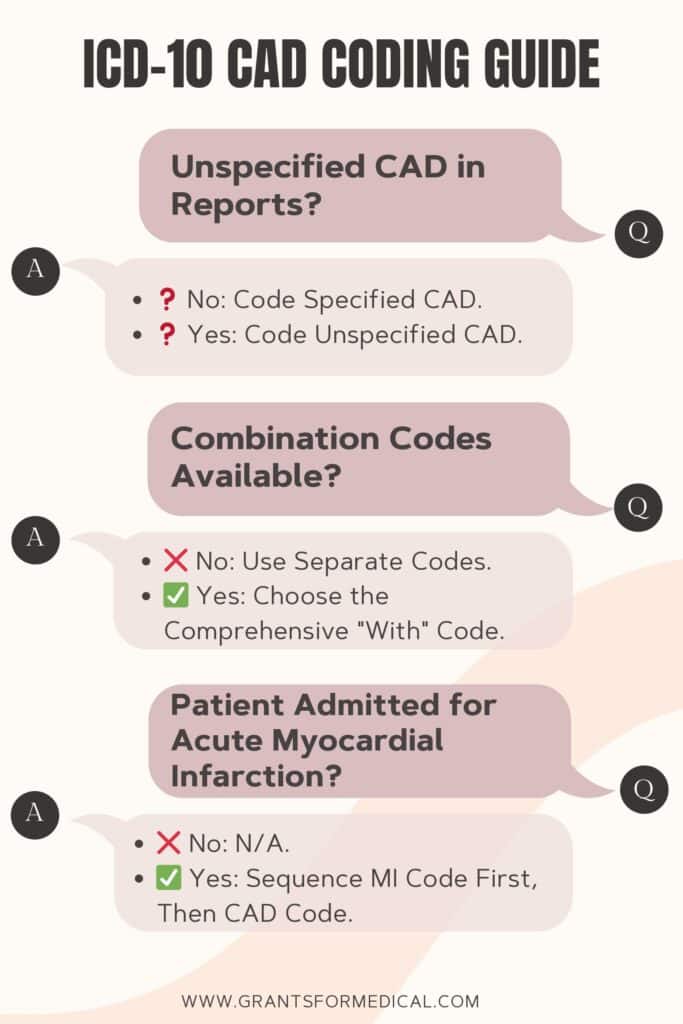ICD-10 CAD Coding
ICD 10 code for CAD (coronary artery disease) is I25. This code falls under the category of “Ischemic heart diseases,” which includes conditions that result from reduced blood flow to the heart due to narrowed or blocked blood vessels. The ICD-10 code I25 can be further specified based on the location and severity of the heart disease, as well as any other associated complications.
What is Coronary Artery Disease (CAD)?
The narrowing or blockage of the arteries supply blood to the heart. CAD happens when the major blood vessels that supply the heart become damaged or deposited by plaques. These plaques contain cholesterol and cause inflammation and blockage of coronary arteries.
As the coronary arteries supply blood to the heart and carry oxygen and nutrients, blood deprivation can cause damage to the heart walls and even heart attack.
Symptoms of coronary artery disease:
As coronary artery disease develops over the years, symptoms may take longer to appear after a significant artery blockage. The following are the symptoms of coronary artery disease:

- Angina (chest pain is the most common symptom)
- Shortness of breath
- Pain in shoulders, arms, or jaws
- Dizziness
- Nausea
- Vomiting
- Sweating
- Back pain
- Palpitations
- Lethargy
ICD-10 coding for coronary artery disease:
The World Health Organisation introduced the ICD 10 coding for different diseases, their diagnosis, treatment, billing, and insurance procedures. ICD-10 coding is an updated coding system that makes documenting conditions and the billing process easy and efficient.
ICD-10 codes for coronary artery disease are in chapter 9 of the ICD-10 coding Manual approved by the World Health Organization.
I25 is the parent code for coronary artery disease (CAD). This code is extended and subcategorized in other ICD-10 codes of the I25 series based on types and stages.
Below are the ICD-10-CM codes for CAD:
When the type and stages of CAD are not defined, then use only code:
I25.10- Atherosclerotic heart disease of the native coronary artery without angina pectoris
OR
Atherosclerotic heart disease NOS.
Exclude codes of I25.10:
Excludes codes are those you can not bill together as primary or secondary diagnoses with I25.10.
Below are the excludes for I25.10:
I75- Thrmoboembolsim
I5A- Non-ischemic myocardial injury
Use additional code, if applicable, with I25.10:
- 84- coronary atherosclerosis due to calcified coronary lesion
- 83- coronary atherosclerosis due to lipid-rich plaque
- 22- exposure to environmental tobacco smoke
- 82- chronic total occlusion of coronary artery
- 891- history of tobacco dependence
- 31- occupational exposure to environmental tobacco smoke
- – tobacco dependence
- 0- tobacco use
Combination codes for coronary artery disease:
The ICD-10-CM has combination codes for coronary artery disease with or without angina pectoris. While choosing combination codes, reporting additional codes for angina pectoris is unnecessary.
Below are the subcategories for atherosclerotic heart disease with or without angina pectoris:
I25.1- Atherosclerotic heart disease (it includes coronary artery atheroma, coronary artery sclerosis, coronary artery disease, and coronary artery atherosclerosis).
I25.10- Atherosclerotic heart disease of the native coronary artery without angina pectoris (native coronary artery is the one with bypass implanted)
I25.110- Atherosclerotic heart disease of the native coronary artery with unstable angina pectoris (unstable angina does not stop and leads to a heart attack eventually)
I25.111- Atherosclerotic heart disease of the native coronary artery with angina pectoris with documented spasm ( a quick tightening of the artery leading to a decreased blood flow to the heart)
I25.118- Atherosclerotic heart disease of the native coronary artery with other forms of angina pectoris (may include variant and microvascular angina)
I25.119- Atherosclerotic heart disease of the native coronary artery with unspecified angina pectoris
I25.700- Atherosclerosis of the coronary artery bypass graft, unspecified, with unstable angina pectoris (plaque formation in the graft can lead to late graft failure).
I25.701- Atherosclerosis of the coronary artery bypass graft, unspecified, with angina pectoris with documented spasm
I25.708- Atherosclerosis of the coronary artery bypass graft, unspecified, with other forms of angina pectoris
I25.709- Atherosclerosis of the coronary artery bypass graft, unspecified, with unspecified angina pectoris
I25.710- Atherosclerosis of autologous vein coronary artery bypass graft with unstable angina pectoris (autologous vein is derived from the same person to be grafted).
I25.711- Atherosclerosis of autologous vein coronary artery bypass graft with unstable angina pectoris with documented spasm
I25.718- Atherosclerosis of autologous vein coronary artery bypass graft with other forms of angina pectoris
I25.719- Atherosclerosis of autologous vein coronary artery bypass graft with unspecified angina pectoris
I25.720- Atherosclerosis of autologous artery coronary artery bypass graft with unstable angina pectoris
I25.721- Atherosclerosis of autologous artery coronary artery bypass graft with angina pectoris with documented spasm
I25.728- Atherosclerosis of autologous artery coronary artery bypass graft with other forms of angina pectoris
I25.729- Atherosclerosis of autologous artery coronary artery bypass graft with unspecified angina pectoris
I25.730- Atherosclerosis of nonautologous biological coronary artery bypass graft with unstable angina pectoris (grafting material does not originate from the patient in nonautologous grafting).
I25.731- Atherosclerosis of nonautologous biological coronary artery bypass graft with angina pectoris with documented spasm
I25.738- Atherosclerosis of nonautologous biological coronary artery bypass graft with other forms of angina pectoris
I25.739- atherosclerosis of nonautologous biological coronary artery bypass graft with unspecified angina pectoris
I25.750- Atherosclerosis of native coronary artery of transplanted heart with unstable angina pectoris
I25.751- Atherosclerosis of native coronary artery of transplanted heart with angina pectoris with documented spasm
I25.758- Atherosclerosis of native coronary artery of transplanted heart with other forms of angina pectoris
I25.759- Atherosclerosis of native coronary artery of transplanted heart with unspecified angina pectoris
I25.760- Atherosclerosis of bypass graft of coronary artery of transplanted heart with unstable angina pectoris
I25.769- Atherosclerosis of bypass graft of coronary artery of transplanted heart with unspecified angina pectoris
I25.790- Atherosclerosis of other coronary artery bypass graft with unstable angina pectoris
I25.791- Atherosclerosis of other coronary artery bypass graft with angina pectoris with documented spasm
I25.798- atherosclerosis of other coronary artery bypass graft with other forms of angina pectoris
I25.799- Atherosclerosis of other coronary artery bypass graft with unspecified angina pectoris
I25.810- Atherosclerosis of coronary artery bypass graft without angina pectoris
I25.811- Atherosclerosis of native coronary artery of transplanted heart without angina pectoris
I25.812- Atherosclerosis of bypass graft of coronary artery of transplanted heart without angina pectoris
Other associated CAD conditions:
I25.2- Old myocardial infarction ( a previous heart attack due to necrosis of the heart muscle because of hypoxia)
This code is also used for healed myocardial infarction and past myocardial infarction that are currently without symptoms.
I25.3- Aneurysm of the heart (it is a balloon-shaped bulge in a weakened ventricular wall of the heart).
This code covers both terms- mural and ventricular Aneurysm.
I25.41- Coronary artery aneurysm (thinning and dilation of the coronary artery)
I25.42- Coronary artery dissection (tearing of the coronary artery wall)
Both the codes mentioned above exclude congenital coronary artery aneurysms.
I25.5- Ischemic cardiomyopathy (ineffective blood pumping by weakened cardiac muscles due to hypoxia).
I25.6- Silent myocardial ischemia (myocardial ischemia without chest discomfort or other symptoms).
I25.8- Other forms of chronic ischemic heart disease
It covers any chronic conditions mentioned in I21, I22, and I24 code series.
I25.82- Chronic total occlusion of the coronary artery (plaque blocks the artery for over 90 days).
I25.83- Coronary atherosclerosis due to lipid-rich plaque (higher cholesterol deposits)
I25.84- Coronary atherosclerosis due to calcified coronary lesion (calcium deposition due to chronic plaques)
I25.89- Other forms of chronic ischemic heart disease
I25.9- Chronic ischemic heart disease, unspecified
It codes ischemic heart disease (chronic) NOS.

Coding guide for CAD:
- When the CAD condition is not specified in medical reports, then code only the unspecified code.
- Combination codes are available for CAD with angina, without angina, with grafts, without grafts, etc. In such scenarios, do not code these conditions separately with two different codes to fulfill a requirement. Always choose one code that contains all the ”with” conditions.
- If a patient with CAD is admitted due to an acute myocardial infarction, then the Acute myocardial infarction code should be sequenced first to the coronary artery disease.
ICD-10 CAD Frequently Asked Questions
How Does Coronary Artery Disease (CAD) Occur?
It is the narrowing or blockage of the arteries that supply blood to the heart. CAD happens when the major blood vessels that supply the heart become damaged or deposited by plaques. These plaques contain cholesterol and cause inflammation and blockage of coronary arteries.
What is the parent code for Coronary Artery Disease in ICD 10 index?
I25 is the parent code for coronary artery disease (CAD). This code is extended and subcategorized in other ICD-10 codes of the I25 series based on types and stages.
What is the ICD-10 Code for CAD with description?
I25.10- Atherosclerotic heart disease of the native coronary artery without angina pectoris ORAtherosclerotic heart disease NOS.
What are the major causes of CAD?
Physical inactivity, overweight, consuming too much fatty diet, smoking and alcohol are the major causes and risk factors of CAD.
What is ischemic heart disease?
Ischemic heart disease is a condition in which blood flow to the heart is reduced due to obstruction of the blood vessels.
What is the ICD 10 code for coronary artery disease?
I25.10 is the diagnosis code for coronary artery disease.
What does CAD stands for?
CAD stands for coronary artery disease.
What is angina pectoris?
Angina pectoris is commonly known as chest pain or discomfort in the back that could be the alarming sign of heart attack.
See Also